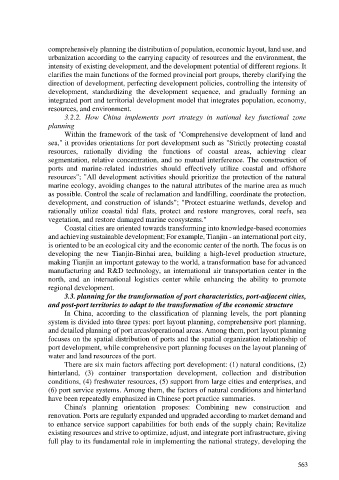Page 571 - Ebook HTKH 2024
P. 571
comprehensively planning the distribution of population, economic layout, land use, and
urbanization according to the carrying capacity of resources and the environment, the
intensity of existing development, and the development potential of different regions. It
clarifies the main functions of the formed provincial port groups, thereby clarifying the
direction of development, perfecting development policies, controlling the intensity of
development, standardizing the development sequence, and gradually forming an
integrated port and territorial development model that integrates population, economy,
resources, and environment.
3.2.2. How China implements port strategy in national key functional zone
planning
Within the framework of the task of "Comprehensive development of land and
sea," it provides orientations for port development such as "Strictly protecting coastal
resources, rationally dividing the functions of coastal areas, achieving clear
segmentation, relative concentration, and no mutual interference. The construction of
ports and marine-related industries should effectively utilize coastal and offshore
resources"; "All development activities should prioritize the protection of the natural
marine ecology, avoiding changes to the natural attributes of the marine area as much
as possible. Control the scale of reclamation and landfilling, coordinate the protection,
development, and construction of islands"; "Protect estuarine wetlands, develop and
rationally utilize coastal tidal flats, protect and restore mangroves, coral reefs, sea
vegetation, and restore damaged marine ecosystems."
Coastal cities are oriented towards transforming into knowledge-based economies
and achieving sustainable development; For example, Tianjin - an international port city,
is oriented to be an ecological city and the economic center of the north. The focus is on
developing the new Tianjin-Binhai area, building a high-level production structure,
making Tianjin an important gateway to the world, a transformation base for advanced
manufacturing and R&D technology, an international air transportation center in the
north, and an international logistics center while enhancing the ability to promote
regional development.
3.3. planning for the transformation of port characteristics, port-adjacent cities,
and post-port territories to adapt to the transformation of the economic structure
In China, according to the classification of planning levels, the port planning
system is divided into three types: port layout planning, comprehensive port planning,
and detailed planning of port areas/operational areas. Among them, port layout planning
focuses on the spatial distribution of ports and the spatial organization relationship of
port development, while comprehensive port planning focuses on the layout planning of
water and land resources of the port.
There are six main factors affecting port development: (1) natural conditions, (2)
hinterland, (3) container transportation development, collection and distribution
conditions, (4) freshwater resources, (5) support from large cities and enterprises, and
(6) port service systems. Among them, the factors of natural conditions and hinterland
have been repeatedly emphasized in Chinese port practice summaries.
China's planning orientation proposes: Combining new construction and
renovation. Ports are regularly expanded and upgraded according to market demand and
to enhance service support capabilities for both ends of the supply chain; Revitalize
existing resources and strive to optimize, adjust, and integrate port infrastructure, giving
full play to its fundamental role in implementing the national strategy, developing the
563

